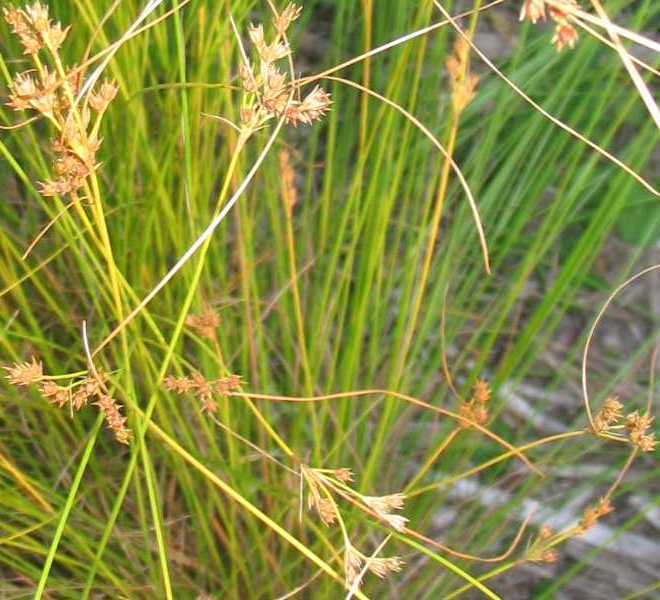Exploring Wrinkled Rush
Scientifically recognized as Juncus dudleyi and classified under Family Juncaceae, stands out as a distinctive Herbaceous perennial known for its unique characteristics. While it may also be found under other Synonyms, Juncus effusus, Juncus tenuis.withNot typically cultivated as a variety form. You can use our free plant care app PlantPlants to identify Wrinkled Rush.
Temperature
Can tolerate temperatures down to 20 F (-6 C)
Watering
Regular watering; prefers consistently moist conditions
Fertilizing
Balanced water-soluble fertilizer
Sunlight
Full sun to partial shade
Toxicity
Generally non-toxic



Appearance and Growth Of Wrinkled Rush
At maturity, this species reaches approximately 1 to 3 feet tall, presenting Long, narrow leaves with a wrinkled appearance along with Small, brownish or greenish flowers in loose clusters, followed by Capsules containing numerous small seeds. These features are supported by a reliable Fibrous root system, ensuring stability and sustained growth.
Wrinkled Rush Origin and Habitat
Native to North America, predominantly in wetland areas, Wrinkled Rush thrives in Prefers wetlands, marshes, and along riverbanks at elevations around Sea level to 1,000 meters. Best suited for USDA Hardiness Zone Zones 3 to 9. Whether grown indoor, in a curated garden or a more natural setting, its ecological requirements help maintain its vigor over time.
How to take Care of Wrinkled Rush
Light, Soil and Watering Wrinkled Rush.
You can use our free plant identify app PlantPlants to chose the best spot for Wrinkled Rush, This plant prefers Full sun to partial shade and flourishes in Wet, boggy, or clay soils with a soil pH of about 6.0 7.5.
Wrinkled Rush needs watering,Regular watering; prefers consistently moist conditions, guided by PlantPlants app, You can get plants daily watering schedule. to maintain Wet, ensure steady hydration. Applying water through Watered by flooding or consistent moisture supports even distribution and helps prevent overwatering or dryness.
Temperature and Humidity
Wrinkled Rush performs best within 50 F to 85 F (10 C to 29 C). Its ideal growth occurs at around 70 F to 75 F (21 C to 24 C), though it tolerates ranges from Can tolerate temperatures down to 20 F (-6 C). Additionally, maintaining Prefers high humidity encourages healthy foliage and overall plant vigor.
Fertilization & Soil Health
Feeding with Balanced water-soluble fertilizer at the recommended Seasonal Application Frequency on PlantPlants App keeps nutrients balanced. Incorporating Organic matter such as compost enhances soil structure and fertility, while staying alert to Yellowing of leaves, stunted growth helps you adjust care as needed to maintain optimal plant health.
Routine and Maintenance
Regular attention ensures this plant’s beauty and longevity. Late winter to early spring before growth resumes for Remove dead or damaged leaves tidies its appearance, while Every 2-3 years may be necessary as it grows, requiring a Increase pot size by 1-2 inches in diameter increase and a fresh 50% potting soil, 25% peat moss, 25% perlite. for Staking or Support. Usually does not require staking.
Seasonal Changes and Propagation of Wrinkled Rush
During Late fall to early spring, growth may slow and some Leaves may die back in winter but remain green during mild winters can occur. For those looking to propagate, consider Division, seeds and provide Requires moist conditions; germination can occur within 2-4 weeks when starting from seed. If using cuttings, follow Take stem cuttings, keep in water until roots develop to ensure successful rooting and healthy new plants.
Pests, Diseases and Prevention
our free plant identify and care app PlantPlants can help you diagnosisWrinkled Rush problems.Though generally robust, keep watch for Aphids, snails and remain vigilant against Root rot if overwatered. Implementing Good air circulation and drainage and applying Insecticidal soap for pests; improve drainage for diseases when issues arise will help sustain the plant thriving.
Companions and Uses of Wrinkled Rush
This plant pairs nicely with Other wetland plants such as sedges and reeds and shows Minimal known interactions, making it a flexible choice for various Used in rain gardens and wetland restoration.
Edible and Cultural Aspects
the Edible Parts: Young shoots and seeds (though not widely consumed). Toxicty of Wrinkled Rush, Generally non-toxic. learning about its Spring for shoots; seeds can be collected in late summer, Young shoots can be used in salads, and High in fiber can be intriguing for culinary explorers. Some traditions highlight its Traditionally used to treat various ailments (requires research verification) or note its Perhaps used in traditional crafts by indigenous cultures.
Conservation and Status
With an Not listed (appears to be stable in its habitat), proper Protection of wetland habitats





